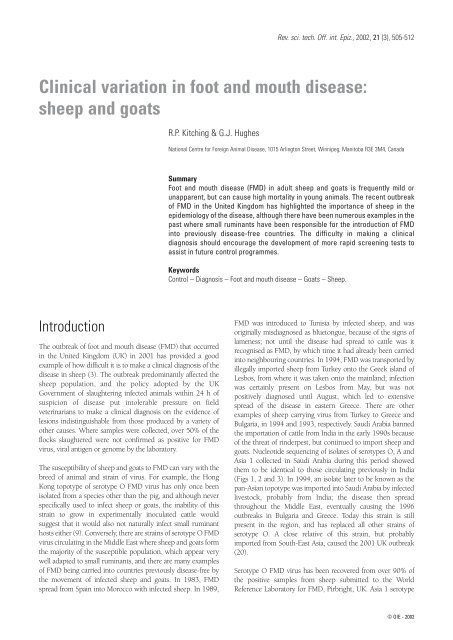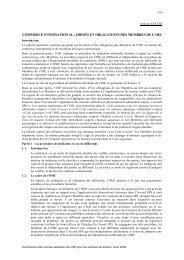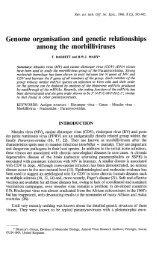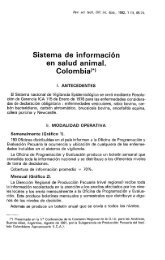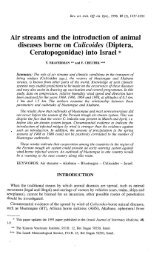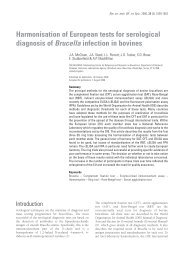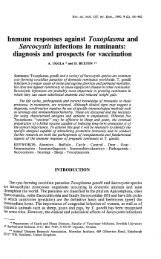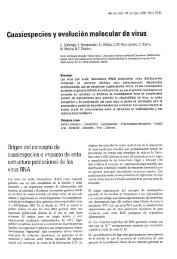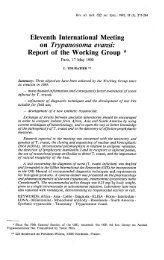Clinical variation in foot and mouth disease: sheep and goats
Clinical variation in foot and mouth disease: sheep and goats
Clinical variation in foot and mouth disease: sheep and goats
You also want an ePaper? Increase the reach of your titles
YUMPU automatically turns print PDFs into web optimized ePapers that Google loves.
Rev. sci. tech. Off. <strong>in</strong>t. Epiz., 2002, 21 (3), 505-512<br />
<strong>Cl<strong>in</strong>ical</strong> <strong>variation</strong> <strong>in</strong> <strong>foot</strong> <strong>and</strong> <strong>mouth</strong> <strong>disease</strong>:<br />
<strong>sheep</strong> <strong>and</strong> <strong>goats</strong><br />
R.P. Kitch<strong>in</strong>g & G.J. Hughes<br />
National Centre for Foreign Animal Disease, 1015 Arl<strong>in</strong>gton Street, W<strong>in</strong>nipeg, Manitoba R3E 3M4, Canada<br />
Summary<br />
Foot <strong>and</strong> <strong>mouth</strong> <strong>disease</strong> (FMD) <strong>in</strong> adult <strong>sheep</strong> <strong>and</strong> <strong>goats</strong> is frequently mild or<br />
unapparent, but can cause high mortality <strong>in</strong> young animals. The recent outbreak<br />
of FMD <strong>in</strong> the United K<strong>in</strong>gdom has highlighted the importance of <strong>sheep</strong> <strong>in</strong> the<br />
epidemiology of the <strong>disease</strong>, although there have been numerous examples <strong>in</strong> the<br />
past where small rum<strong>in</strong>ants have been responsible for the <strong>in</strong>troduction of FMD<br />
<strong>in</strong>to previously <strong>disease</strong>-free countries. The difficulty <strong>in</strong> mak<strong>in</strong>g a cl<strong>in</strong>ical<br />
diagnosis should encourage the development of more rapid screen<strong>in</strong>g tests to<br />
assist <strong>in</strong> future control programmes.<br />
Keywords<br />
Control – Diagnosis – Foot <strong>and</strong> <strong>mouth</strong> <strong>disease</strong> – Goats – Sheep.<br />
Introduction<br />
The outbreak of <strong>foot</strong> <strong>and</strong> <strong>mouth</strong> <strong>disease</strong> (FMD) that occurred<br />
<strong>in</strong> the United K<strong>in</strong>gdom (UK) <strong>in</strong> 2001 has provided a good<br />
example of how difficult it is to make a cl<strong>in</strong>ical diagnosis of the<br />
<strong>disease</strong> <strong>in</strong> <strong>sheep</strong> (3). The outbreak predom<strong>in</strong>antly affected the<br />
<strong>sheep</strong> population, <strong>and</strong> the policy adopted by the UK<br />
Government of slaughter<strong>in</strong>g <strong>in</strong>fected animals with<strong>in</strong> 24 h of<br />
suspicion of <strong>disease</strong> put <strong>in</strong>tolerable pressure on field<br />
veter<strong>in</strong>arians to make a cl<strong>in</strong>ical diagnosis on the evidence of<br />
lesions <strong>in</strong>dist<strong>in</strong>guishable from those produced by a variety of<br />
other causes. Where samples were collected, over 50% of the<br />
flocks slaughtered were not confirmed as positive for FMD<br />
virus, viral antigen or genome by the laboratory.<br />
The susceptibility of <strong>sheep</strong> <strong>and</strong> <strong>goats</strong> to FMD can vary with the<br />
breed of animal <strong>and</strong> stra<strong>in</strong> of virus. For example, the Hong<br />
Kong topotype of serotype O FMD virus has only once been<br />
isolated from a species other than the pig, <strong>and</strong> although never<br />
specifically used to <strong>in</strong>fect <strong>sheep</strong> or <strong>goats</strong>, the <strong>in</strong>ability of this<br />
stra<strong>in</strong> to grow <strong>in</strong> experimentally <strong>in</strong>oculated cattle would<br />
suggest that it would also not naturally <strong>in</strong>fect small rum<strong>in</strong>ant<br />
hosts either (9). Conversely, there are stra<strong>in</strong>s of serotype O FMD<br />
virus circulat<strong>in</strong>g <strong>in</strong> the Middle East where <strong>sheep</strong> <strong>and</strong> <strong>goats</strong> form<br />
the majority of the susceptible population, which appear very<br />
well adapted to small rum<strong>in</strong>ants, <strong>and</strong> there are many examples<br />
of FMD be<strong>in</strong>g carried <strong>in</strong>to countries previously <strong>disease</strong>-free by<br />
the movement of <strong>in</strong>fected <strong>sheep</strong> <strong>and</strong> <strong>goats</strong>. In 1983, FMD<br />
spread from Spa<strong>in</strong> <strong>in</strong>to Morocco with <strong>in</strong>fected <strong>sheep</strong>. In 1989,<br />
FMD was <strong>in</strong>troduced to Tunisia by <strong>in</strong>fected <strong>sheep</strong>, <strong>and</strong> was<br />
orig<strong>in</strong>ally misdiagnosed as bluetongue, because of the signs of<br />
lameness; not until the <strong>disease</strong> had spread to cattle was it<br />
recognised as FMD, by which time it had already been carried<br />
<strong>in</strong>to neighbour<strong>in</strong>g countries. In 1994, FMD was transported by<br />
illegally imported <strong>sheep</strong> from Turkey onto the Greek isl<strong>and</strong> of<br />
Lesbos, from where it was taken onto the ma<strong>in</strong>l<strong>and</strong>; <strong>in</strong>fection<br />
was certa<strong>in</strong>ly present on Lesbos from May, but was not<br />
positively diagnosed until August, which led to extensive<br />
spread of the <strong>disease</strong> <strong>in</strong> eastern Greece. There are other<br />
examples of <strong>sheep</strong> carry<strong>in</strong>g virus from Turkey to Greece <strong>and</strong><br />
Bulgaria, <strong>in</strong> 1994 <strong>and</strong> 1993, respectively. Saudi Arabia banned<br />
the importation of cattle from India <strong>in</strong> the early 1990s because<br />
of the threat of r<strong>in</strong>derpest, but cont<strong>in</strong>ued to import <strong>sheep</strong> <strong>and</strong><br />
<strong>goats</strong>. Nucleotide sequenc<strong>in</strong>g of isolates of serotypes O, A <strong>and</strong><br />
Asia 1 collected <strong>in</strong> Saudi Arabia dur<strong>in</strong>g this period showed<br />
them to be identical to those circulat<strong>in</strong>g previously <strong>in</strong> India<br />
(Figs 1, 2 <strong>and</strong> 3). In 1994, an isolate later to be known as the<br />
pan-Asian topotype was imported <strong>in</strong>to Saudi Arabia by <strong>in</strong>fected<br />
livestock, probably from India; the <strong>disease</strong> then spread<br />
throughout the Middle East, eventually caus<strong>in</strong>g the 1996<br />
outbreaks <strong>in</strong> Bulgaria <strong>and</strong> Greece. Today this stra<strong>in</strong> is still<br />
present <strong>in</strong> the region, <strong>and</strong> has replaced all other stra<strong>in</strong>s of<br />
serotype O. A close relative of this stra<strong>in</strong>, but probably<br />
imported from South-East Asia, caused the 2001 UK outbreak<br />
(20).<br />
Serotype O FMD virus has been recovered from over 90% of<br />
the positive samples from <strong>sheep</strong> submitted to the World<br />
Reference Laboratory for FMD, Pirbright, UK. Asia 1 serotype<br />
© OIE - 2002
506 Rev. sci. tech. Off. <strong>in</strong>t. Epiz., 21 (3)<br />
A5/Allier/60<br />
A22/IRQ/24/64<br />
A22/IND/300/94<br />
A/SAU/16/95<br />
17.9%<br />
A/SAU/19/95<br />
A/SAU/24/95<br />
A/SAU/35/94<br />
A/TUR/3/95<br />
18 16 14 12 10 8 6 4 2 0<br />
Percentage nucleotide difference (nt 475-639 of VP1)<br />
Fig. 1<br />
Dendrogram show<strong>in</strong>g the close genomic relationship between <strong>foot</strong> <strong>and</strong> <strong>mouth</strong> <strong>disease</strong> serotype A isolates from India <strong>and</strong> Saudi Arabia<br />
(N.J. Knowles, personal communication)<br />
has also been isolated from goat samples submitted from<br />
Bangladesh <strong>and</strong> <strong>goats</strong> imported from this country were<br />
responsible for an outbreak of Asia 1 <strong>in</strong> Kuwait. Isolation of<br />
other serotypes is rare, but does not necessarily <strong>in</strong>dicate that<br />
<strong>in</strong>fection of small rum<strong>in</strong>ants with these serotypes does not<br />
occur; for example, Kuwait reported isolat<strong>in</strong>g South African<br />
Territories (SAT 2) virus from <strong>sheep</strong> dur<strong>in</strong>g the <strong>in</strong>cursion of<br />
FMD <strong>in</strong>to Saudi Arabia dur<strong>in</strong>g 2000. However, even <strong>in</strong> East<br />
Africa, where outbreaks due to serotypes O, A, C, SAT 1 <strong>and</strong> 2<br />
are common, predom<strong>in</strong>antly serotype O virus was identified <strong>in</strong><br />
cl<strong>in</strong>ically affected <strong>sheep</strong> <strong>and</strong> <strong>goats</strong>.<br />
Transmission<br />
As is the case with other rum<strong>in</strong>ants, <strong>sheep</strong> <strong>and</strong> <strong>goats</strong> are highly<br />
susceptible to <strong>in</strong>fection with FMD virus by the aerosol route,<br />
with as little as 20 TCID 50 (tissue culture <strong>in</strong>fectious doses) be<strong>in</strong>g<br />
sufficient for <strong>in</strong>fection. Aerosol production by <strong>in</strong>fected pigs can<br />
be as high as log 10 8.6 TCID 50 per day, theoretically sufficient to<br />
<strong>in</strong>fect over 20 million <strong>sheep</strong>. Aerosol production by <strong>in</strong>fected<br />
<strong>sheep</strong>, however, is considerably less, <strong>and</strong> whereas there are<br />
reports of airborne virus spread<strong>in</strong>g from pigs over 250 km to<br />
<strong>in</strong>fect cattle (France to Engl<strong>and</strong> <strong>in</strong> 1981) (5), aerosol<br />
PAK/1/54<br />
TAI/2/95<br />
IND/26/95<br />
14.8%<br />
IND/40/95<br />
IND/233/95<br />
IND/43/95<br />
SAU/39/94<br />
SAU/40/94<br />
IND/51/95<br />
18 16 14 12 10 8 6 4 2 0<br />
Percentage nucleotide difference (nt 475-636 of VP1)<br />
Fig. 2<br />
Dendrogram show<strong>in</strong>g the close genomic relationship between <strong>foot</strong> <strong>and</strong> <strong>mouth</strong> <strong>disease</strong> serotype Asia 1 isolates from India <strong>and</strong> Saudi Arabia<br />
(N.J. Knowles, personal communication)<br />
© OIE - 2002
Rev. sci. tech. Off. <strong>in</strong>t. Epiz., 21 (3) 507<br />
O1/Kaufbeuren/66<br />
O1/Manisa/69<br />
15.4%<br />
O/IND/6/94<br />
O/IND/9/94<br />
O/SAU/15/94<br />
O/SAU/62/94<br />
O/SAU/65/94<br />
O/SAU/58/94<br />
O/SAU/72/94<br />
O/SAU/100/94<br />
O/SAU/28/95<br />
O/SAU/14/95<br />
O/SAU/20/95<br />
O/SAU/77/94<br />
18 16 14 12 10 8 6 4 2 0<br />
Percentage nucleotide difference (nt 475-639 of VP1)<br />
Fig. 3<br />
Dendrogram show<strong>in</strong>g the close genomic relationship between <strong>foot</strong> <strong>and</strong> <strong>mouth</strong> <strong>disease</strong> serotype O isolates from India <strong>and</strong> Saudi Arabia<br />
(N.J. Knowles, personal communication)<br />
transmission from <strong>in</strong>fected <strong>sheep</strong> is unlikely to occur over<br />
distances greater than 100 metres (7, 26). Sheep are also less<br />
likely to become <strong>in</strong>fected by airborne virus than cattle because<br />
of their lower respiratory volume. Sheep <strong>and</strong> <strong>goats</strong> are probably<br />
most often <strong>in</strong>fected by direct contact with <strong>in</strong>fected animals. The<br />
virus may <strong>in</strong>fect <strong>sheep</strong> <strong>and</strong> <strong>goats</strong> through abrasions on the sk<strong>in</strong><br />
or mucous membranes, through contam<strong>in</strong>ated food, as well as<br />
by the respiratory route. Dur<strong>in</strong>g the FMD outbreak that took<br />
place <strong>in</strong> the UK <strong>in</strong> 2001, <strong>disease</strong> spread was reported to occur<br />
frequently by mechanical carriage of virus between flocks by<br />
humans or vehicles.<br />
Sheep-to-<strong>sheep</strong> spread by contact appears to be restricted, to<br />
the extent that the rate of transmission with<strong>in</strong> an affected flock<br />
is lower than that observed <strong>in</strong> <strong>in</strong>fected pig or cattle herds. A<br />
good example of this phenomenon is illustrated by the<br />
outbreak of FMD that took place <strong>in</strong> Greece dur<strong>in</strong>g 1994.<br />
Serological <strong>in</strong>vestigations showed that <strong>in</strong> many of the affected<br />
flocks not all <strong>in</strong>dividuals had sero-converted to the virus,<br />
<strong>in</strong>dicat<strong>in</strong>g that the virus had not dissem<strong>in</strong>ated sufficiently to<br />
<strong>in</strong>fect entire flocks. In some flocks affected towards the end of<br />
the outbreak, only 20% of the <strong>sheep</strong> were sero-positive (21).<br />
There was suspicion, but little firm evidence, that the 1993<br />
outbreak of FMD <strong>in</strong> Italy had also failed to ma<strong>in</strong>ta<strong>in</strong> itself <strong>in</strong><br />
affected <strong>sheep</strong> flocks. Similarly, evidence from the recent UK<br />
epidemic shows considerable <strong>variation</strong> <strong>in</strong> the level of <strong>in</strong>tra-flock<br />
<strong>in</strong>fection rates. On one farm visited, only 5% of 237 <strong>sheep</strong> that<br />
were blood tested were sero-positive, <strong>and</strong> 3% were viruspositive,<br />
whereas 91% of the 75 cattle present were cl<strong>in</strong>ically<br />
affected. On a second farm tested, 8% of 148 <strong>sheep</strong> were seropositive,<br />
24% virus-positive, whilst 98 of 100 cattle showed<br />
cl<strong>in</strong>ical signs (1). A recent study by Hughes (14) has provided<br />
supportive evidence for the observed difference between the<br />
dynamics of FMD transmission <strong>in</strong> <strong>sheep</strong> populations as<br />
compared with cattle <strong>and</strong> pigs. The study showed that, us<strong>in</strong>g<br />
the 1994 Greek outbreak stra<strong>in</strong>, there was significant reduction<br />
<strong>in</strong> the level of <strong>in</strong>fection <strong>and</strong> estimated transmission rates over<br />
time dur<strong>in</strong>g serial passage through groups of <strong>sheep</strong>. These<br />
results <strong>in</strong>fer that some, possibly most, stra<strong>in</strong>s of FMD virus may<br />
die out if they are restricted to <strong>sheep</strong>. Infection of cattle or pigs<br />
may be sufficient to <strong>in</strong>crease the level of circulat<strong>in</strong>g virus <strong>and</strong><br />
consequently the probability of transmission of <strong>in</strong>fection to<br />
© OIE - 2002
508 Rev. sci. tech. Off. <strong>in</strong>t. Epiz., 21 (3)<br />
<strong>in</strong>-contact <strong>sheep</strong>, thereby re-establish<strong>in</strong>g the <strong>disease</strong>. This<br />
hypothesis requires further <strong>in</strong>vestigation us<strong>in</strong>g other stra<strong>in</strong>s of<br />
FMD virus. The limited transmission that may occur with<strong>in</strong><br />
closed <strong>sheep</strong> populations is also often masked by the lack of<br />
cl<strong>in</strong>ical signs (see above).<br />
The probability of transmission of FMD virus from <strong>in</strong>fected<br />
<strong>sheep</strong> is highest dur<strong>in</strong>g the viraemic phase <strong>and</strong> peaks at or just<br />
before the appearance of cl<strong>in</strong>ical signs. This period correlates<br />
well with the period of virus excretion (4) which ends at the<br />
po<strong>in</strong>t of sero-conversion (2). Levels of virus excretion are stra<strong>in</strong>specific<br />
(4).<br />
<strong>Cl<strong>in</strong>ical</strong> signs<br />
The <strong>in</strong>cubation period <strong>in</strong> <strong>sheep</strong> follow<strong>in</strong>g <strong>in</strong>fection with FMD<br />
virus is usually between three <strong>and</strong> eight days (19), but can be<br />
as short as 24 h follow<strong>in</strong>g experimental <strong>in</strong>oculation, or as long<br />
as twelve days, depend<strong>in</strong>g on the susceptibility of the <strong>sheep</strong>, the<br />
dose of virus <strong>and</strong> the route of <strong>in</strong>fection. The duration of<br />
viraemia is between one <strong>and</strong> five days. Hughes et al. (15) were<br />
unable to detect viraemia <strong>in</strong> 8% of <strong>sheep</strong> that sero-converted <strong>in</strong><br />
a series of transmission experiments. <strong>Cl<strong>in</strong>ical</strong> signs appear up to<br />
three days after the start of viraemia, approximately seven days<br />
after exposure to contact <strong>in</strong>fection – giv<strong>in</strong>g the period between<br />
exposure to <strong>in</strong>fection <strong>and</strong> the onset of viraemia as between<br />
three <strong>and</strong> seven days (13, 15). Vesicular <strong>disease</strong> may fail to<br />
develop <strong>in</strong> approximately 25% of <strong>in</strong>fected <strong>sheep</strong> (12, 15), a<br />
further 20% may develop only a s<strong>in</strong>gle observable lesion. In<br />
79 <strong>sheep</strong> <strong>in</strong>fected with the 1994 Greek stra<strong>in</strong>, lesions <strong>in</strong> those<br />
animals that developed vesicular <strong>disease</strong> were visible for less<br />
than three days (15).<br />
Lameness is usually the first <strong>in</strong>dication of FMD <strong>in</strong> <strong>sheep</strong> <strong>and</strong><br />
<strong>goats</strong> (Fig. 4). An affected animal develops fever, is reluctant to<br />
walk, <strong>and</strong> may separate itself from the rest of the flock. In the<br />
field situation, lameness due to other causes may already be<br />
present <strong>and</strong> may conceal the presence of FMD. Vesicles may<br />
develop <strong>in</strong> the <strong>in</strong>terdigital cleft, on the heel bulbs <strong>and</strong> on the<br />
coronary b<strong>and</strong>, but they usually rupture rapidly (Fig. 5) <strong>and</strong><br />
their appearance may be hidden by the coexist<strong>in</strong>g presence of<br />
<strong>foot</strong> rot. Hair or wool may have to be deflected upwards to<br />
render lesions on the coronary b<strong>and</strong> visible, but, <strong>in</strong> <strong>sheep</strong>,<br />
lesions can easily be confused with the coronitis seen with<br />
bluetongue. Vesicles also form <strong>in</strong> the <strong>mouth</strong>, but they rupture<br />
easily <strong>and</strong> are usually only seen as shallow erosions, most<br />
commonly on the dental pad, adjacent to the <strong>in</strong>cisors (Fig. 6),<br />
but also on the tongue, hard palate, lips <strong>and</strong> gums. In one study,<br />
of 57 <strong>sheep</strong> with <strong>foot</strong> lesions due to FMD, only 4 had <strong>mouth</strong><br />
lesions <strong>and</strong> only 2 of these had <strong>mouth</strong> lesions without <strong>foot</strong><br />
lesions (15). Vesicles may also be observed on the teats,<br />
particularly of milk<strong>in</strong>g <strong>sheep</strong> <strong>and</strong> <strong>goats</strong> <strong>and</strong> rarely, on the vulva<br />
Fig. 5<br />
Coronary b<strong>and</strong> lesions due to <strong>foot</strong> <strong>and</strong> <strong>mouth</strong> <strong>disease</strong> are<br />
usually mild, <strong>and</strong> difficult to see<br />
Fig. 4<br />
Lameness is usually the first sign of <strong>foot</strong> <strong>and</strong> <strong>mouth</strong> <strong>disease</strong> <strong>in</strong><br />
<strong>sheep</strong><br />
Fig. 6<br />
A ruptured vesicle on the dental pad of a <strong>sheep</strong> <strong>in</strong>fected with<br />
<strong>foot</strong> <strong>and</strong> <strong>mouth</strong> <strong>disease</strong> virus<br />
© OIE - 2002
Rev. sci. tech. Off. <strong>in</strong>t. Epiz., 21 (3) 509<br />
<strong>and</strong> prepuce. Affected rams are unwill<strong>in</strong>g to work, <strong>and</strong> lactat<strong>in</strong>g<br />
animals suffer a temporary loss of milk yield. Secondary<br />
<strong>in</strong>fections may cause mastitis <strong>and</strong> persistent lameness <strong>and</strong> the<br />
compromised epithelium can predispose to rapid transmission<br />
of other viral <strong>in</strong>fections such as <strong>sheep</strong> <strong>and</strong> goat pox <strong>and</strong> peste<br />
des petits rum<strong>in</strong>ants. Uncomplicated <strong>in</strong>fections with FMD virus<br />
are usually followed by rapid recovery <strong>in</strong> the adult animal.<br />
The cl<strong>in</strong>ical <strong>disease</strong> <strong>in</strong> young lambs <strong>and</strong> kids is characterised by<br />
death without the appearance of vesicles, due to heart failure.<br />
Affected flocks may lose up to 90% of the lamb crop, <strong>and</strong> the<br />
image of large numbers of lambs fall<strong>in</strong>g down dead when<br />
stressed, as may occur when a stranger walks <strong>in</strong>to the flock, is<br />
dramatic.<br />
Pathology<br />
Local replication of FMD virus occurs at the site of entry, <strong>in</strong> the<br />
mucosa of the respiratory tract or at a sk<strong>in</strong> or mucous<br />
membrane abrasion. The virus then spreads throughout the<br />
body favour<strong>in</strong>g epithelial tissue <strong>in</strong> the adult <strong>and</strong> heart muscle <strong>in</strong><br />
the juvenile. Lytic changes <strong>in</strong> the cells of the stratum sp<strong>in</strong>osum<br />
<strong>and</strong> consequent oedema give rise to the characteristic vesicles<br />
<strong>and</strong> accumulation of granulocytes, <strong>and</strong> <strong>in</strong> the develop<strong>in</strong>g<br />
myocardium of young animals, to a lympho-histiocytic<br />
myocarditis (6). Depend<strong>in</strong>g on the speed with which the virus<br />
overwhelms the function of the heart, gross lesions may be<br />
apparent on post mortem as diffuse grey spots or more<br />
organised ‘tiger’ stripes, particularly <strong>in</strong> the left ventricle <strong>and</strong><br />
<strong>in</strong>terventricular septum.<br />
In adult animals, recovery from FMD uncomplicated by<br />
secondary pathogens, is usually rapid, but the virus will persist<br />
<strong>in</strong> the tonsillar tissue for up to n<strong>in</strong>e weeks <strong>in</strong> <strong>sheep</strong> <strong>and</strong> for a<br />
shorter period <strong>in</strong> <strong>goats</strong>.<br />
Diagnosis<br />
<strong>Cl<strong>in</strong>ical</strong> diagnosis of FMD <strong>in</strong> <strong>sheep</strong> <strong>and</strong> <strong>goats</strong> is difficult because<br />
of the usually transient appearance of lesions <strong>and</strong> their<br />
similarity to those caused by other common <strong>disease</strong>s of small<br />
rum<strong>in</strong>ants. Laboratory confirmation of a diagnosis of FMD is<br />
therefore essential. Samples of vesicle epithelium, if available, or<br />
heart muscle from a dead lamb or kid, should be collected <strong>in</strong>to<br />
50% phosphate/glycerol, buffered to pH 7.4-7.6, <strong>and</strong><br />
submitted together with whole <strong>and</strong> clotted blood to a<br />
laboratory equipped to h<strong>and</strong>le the diagnosis <strong>and</strong> with the<br />
necessary <strong>disease</strong>-secure facilities. This will either be a<br />
designated government laboratory or the regional FMD<br />
reference laboratory. Alternatively, samples can be sent to the<br />
World Reference Laboratory for FMD at Pirbright <strong>in</strong> the UK,<br />
follow<strong>in</strong>g the necessary procedures (23). In the laboratory, the<br />
tissue samples will be prepared as a 10% suspension for antigen<br />
detection enzyme-l<strong>in</strong>ked immunosorbent assay (ELISA) (23)<br />
or used directly <strong>in</strong> a polymerase cha<strong>in</strong> reaction (PCR) (24) to<br />
serotype the virus. Sensitive tissue cultures, such as primary<br />
bov<strong>in</strong>e thyroid or lamb kidney cells, will also be <strong>in</strong>oculated<br />
with the tissue suspension <strong>and</strong>/or the whole blood <strong>and</strong> serum,<br />
to grow the virus for further characterisation, <strong>and</strong> to amplify<br />
the antigen if <strong>in</strong>sufficient quantities were present <strong>in</strong> the orig<strong>in</strong>al<br />
sample to provide an <strong>in</strong>itial diagnosis by ELISA. The antigenic<br />
characteristics of the stra<strong>in</strong> will be compared with exist<strong>in</strong>g<br />
vacc<strong>in</strong>e stra<strong>in</strong>s <strong>in</strong> order to identify a suitable vacc<strong>in</strong>e if one is<br />
required, or to confirm the use of one that is already help<strong>in</strong>g to<br />
control the outbreak (17). A segment of the viral genome (part<br />
of the 1D gene) can also be sequenced <strong>and</strong> compared <strong>in</strong> the<br />
reference laboratory database to determ<strong>in</strong>e the relationship of<br />
the virus to other viruses circulat<strong>in</strong>g <strong>in</strong> the region, which may<br />
give an <strong>in</strong>dication of its orig<strong>in</strong> (18).<br />
Due to the difficulty <strong>in</strong> detect<strong>in</strong>g cl<strong>in</strong>ical FMD <strong>in</strong> <strong>sheep</strong> <strong>and</strong><br />
<strong>goats</strong>, the <strong>disease</strong> may be present <strong>in</strong> the flock for a considerable<br />
time prior to discovery <strong>and</strong> samples may be collected from<br />
recover<strong>in</strong>g animals. These animals will no longer have live virus<br />
<strong>in</strong> their tissues, except possibly <strong>in</strong> the pharynx, but antibodies<br />
to FMD virus will be detectable us<strong>in</strong>g either the liquid phase<br />
block<strong>in</strong>g ELISA (23), the solid phase competition ELISA (22)<br />
or the virus neutralisation test (23). However, if vacc<strong>in</strong>e has<br />
been used <strong>in</strong> the flock, these tests will not dist<strong>in</strong>guish between<br />
antibodies result<strong>in</strong>g from <strong>in</strong>fection <strong>and</strong> those result<strong>in</strong>g from<br />
vacc<strong>in</strong>ation. Animals that have been <strong>in</strong>fected with replicat<strong>in</strong>g<br />
virus develop antibodies to the non-structural prote<strong>in</strong>s of FMD<br />
virus, <strong>and</strong> these may be detected us<strong>in</strong>g the 3ABC ELISA or<br />
enzyme-l<strong>in</strong>ked immuno-electrotransfer blot (EITB), although<br />
neither test has been fully validated for use <strong>in</strong> small rum<strong>in</strong>ants<br />
(23). Alternatively, the presence of <strong>in</strong>fection with<strong>in</strong> the flock<br />
can be <strong>in</strong>vestigated by collect<strong>in</strong>g samples us<strong>in</strong>g a probang<br />
sampl<strong>in</strong>g cup which recovers mucous <strong>and</strong> superficial epithelial<br />
cells from the pharynx, the site of virus persistence (16). The<br />
probang sample is then tested for the presence of FMD virus as<br />
for tissue <strong>and</strong> blood samples.<br />
A pen-side diagnostic test would have been particularly<br />
valuable dur<strong>in</strong>g the recent UK outbreak to assist field<br />
veter<strong>in</strong>arians <strong>in</strong> their cl<strong>in</strong>ical diagnosis. One, similar to a test<br />
which had been developed for r<strong>in</strong>derpest diagnosis, was <strong>in</strong> the<br />
process of validation <strong>and</strong> was used with some success towards<br />
the end of the outbreak (11, 25). The test relies on FMD viral<br />
antigen be<strong>in</strong>g recognised by a monoclonal antibody (Mab)<br />
attached to a coloured latex bead. The antigen/Mab/bead<br />
complex is trapped by a fixed b<strong>and</strong> of additional anti-FMD<br />
virus monoclonal antibody as it migrates along a<br />
chromatographic strip, creat<strong>in</strong>g an easily identifiable coloured<br />
l<strong>in</strong>e over the fixed b<strong>and</strong> of Mab as the latex beads concentrate.<br />
The result can be read <strong>in</strong> 10 m<strong>in</strong>utes. However, the test requires<br />
the amount of antigen usually found <strong>in</strong> the epithelium of a<br />
ruptured vesicle, but would not be sufficiently sensitive to<br />
detect antigen <strong>in</strong> a blood sample; <strong>in</strong> many cases of FMD <strong>in</strong><br />
<strong>sheep</strong>, there may not be sufficient epithelium available for the<br />
© OIE - 2002
510 Rev. sci. tech. Off. <strong>in</strong>t. Epiz., 21 (3)<br />
test to be used. Adaptations of the PCR could also provide a<br />
more rapid diagnosis, either to detect viral genome <strong>in</strong> nasal<br />
swabs before the development of cl<strong>in</strong>ical <strong>disease</strong>, or for use <strong>in</strong><br />
portable mach<strong>in</strong>es taken to suspect premises (8).<br />
Once the sample is received by a competent diagnostic<br />
laboratory, <strong>and</strong> assum<strong>in</strong>g the sample was properly collected<br />
<strong>and</strong> stored dur<strong>in</strong>g transport, the available tests are extremely<br />
sensitive <strong>and</strong> specific, <strong>and</strong> for positive samples, the result can<br />
usually be available <strong>in</strong> a few hours. However, before the<br />
laboratory can report that no virus was detected, the sample<br />
must be passaged on tissue culture <strong>and</strong> then bl<strong>in</strong>d-passaged a<br />
further one or two times, each passage requir<strong>in</strong>g 48 hours.<br />
Thus a week may elapse after receipt of a sample <strong>and</strong> before a<br />
f<strong>in</strong>al report is issued from the laboratory. This can <strong>and</strong><br />
frequently does cause some frustration with the field staff, as<br />
quarant<strong>in</strong>e <strong>and</strong> movement restrictions would probably have<br />
been kept <strong>in</strong> place until a result was available. However, there<br />
are many examples where prelim<strong>in</strong>ary negative results have<br />
been issued <strong>and</strong> restrictions prematurely removed, <strong>and</strong> then the<br />
f<strong>in</strong>al result has been reported positive.<br />
Control<br />
The control of FMD <strong>in</strong> <strong>sheep</strong> <strong>and</strong> <strong>goats</strong> follows the same<br />
pr<strong>in</strong>ciples as would apply to the <strong>disease</strong> <strong>in</strong> other susceptible<br />
farm livestock, i.e. movement restrictions, dis<strong>in</strong>fection <strong>and</strong><br />
either slaughter of affected <strong>and</strong> <strong>in</strong>-contact animals or<br />
vacc<strong>in</strong>ation. In countries previously free from FMD, an <strong>in</strong>itial<br />
attempt is usually made to eradicate the <strong>disease</strong> by slaughter.<br />
However, most countries will reta<strong>in</strong> the option to vacc<strong>in</strong>ate <strong>and</strong><br />
thus ma<strong>in</strong>ta<strong>in</strong> membership of a vacc<strong>in</strong>e bank which can<br />
provide vacc<strong>in</strong>e at short notice. In countries that have endemic<br />
FMD, <strong>sheep</strong> may be <strong>in</strong>cluded <strong>in</strong> regular vacc<strong>in</strong>ation campaigns,<br />
although they are rarely vacc<strong>in</strong>ated more than once a year.<br />
Sheep <strong>and</strong> <strong>goats</strong> are usually given half or a third of the cattle<br />
vacc<strong>in</strong>e dose, <strong>and</strong> either oil or alum<strong>in</strong>ium hydroxide/sapon<strong>in</strong><br />
adjuvants can be used. The duration of immunity aga<strong>in</strong>st<br />
<strong>disease</strong> will depend on the severity of challenge with live virus<br />
<strong>in</strong> the field, the antigenic relationship between the vacc<strong>in</strong>e<br />
stra<strong>in</strong> <strong>and</strong> the field virus <strong>and</strong> the potency of the vacc<strong>in</strong>e used.<br />
The often silent nature of the <strong>disease</strong> <strong>in</strong> adult <strong>sheep</strong> <strong>and</strong> <strong>goats</strong><br />
can also give the impression that the vacc<strong>in</strong>ation programme<br />
has been successful, when <strong>in</strong> reality the virus is circulat<strong>in</strong>g<br />
freely. The ability of the particular stra<strong>in</strong> to ma<strong>in</strong>ta<strong>in</strong> itself <strong>in</strong> the<br />
small rum<strong>in</strong>ant population becomes critical <strong>in</strong> these situations,<br />
but, as discussed above, has so far received little attention.<br />
Attempts to vacc<strong>in</strong>ate the national <strong>sheep</strong> population are usually<br />
h<strong>in</strong>dered by the numbers <strong>in</strong>volved, the cost of vacc<strong>in</strong>ation, <strong>and</strong><br />
the resources required to adm<strong>in</strong>ister the vacc<strong>in</strong>e. The <strong>in</strong>itial<br />
<strong>in</strong>tention to <strong>in</strong>clude <strong>sheep</strong> <strong>and</strong> <strong>goats</strong> <strong>in</strong> the vacc<strong>in</strong>ation<br />
campaign throughout Turkey was recognised as unrealistic.<br />
Vacc<strong>in</strong>ation was therefore targeted at all susceptible stock <strong>in</strong><br />
European Turkey (Thrace) <strong>and</strong> only certa<strong>in</strong> areas of Anatolia.<br />
Similarly, Morocco concentrated on vacc<strong>in</strong>at<strong>in</strong>g <strong>sheep</strong> <strong>and</strong><br />
<strong>goats</strong> on the border with Algeria, together with strategic<br />
vacc<strong>in</strong>ation around affected areas dur<strong>in</strong>g the last outbreak of<br />
FMD <strong>in</strong> the country. Uruguay vacc<strong>in</strong>ated only the cattle<br />
population dur<strong>in</strong>g the f<strong>in</strong>al stages of the successful FMD<br />
eradication programme undertaken <strong>in</strong> the early 1990s, <strong>and</strong> left<br />
the approximately 20 million <strong>sheep</strong> unvacc<strong>in</strong>ated dur<strong>in</strong>g this<br />
period.<br />
Conclusion<br />
The recent UK experience has demonstrated the importance of<br />
<strong>sheep</strong> <strong>in</strong> the epidemiology of FMD caused by certa<strong>in</strong> stra<strong>in</strong>s of<br />
virus. The difficulties encountered <strong>in</strong> identify<strong>in</strong>g cl<strong>in</strong>ical <strong>disease</strong><br />
resulted <strong>in</strong> large numbers of healthy animals be<strong>in</strong>g slaughtered,<br />
while other <strong>in</strong>fected flocks went unrecognised, allow<strong>in</strong>g the<br />
virus to spread. While some would argue that the policy<br />
adopted was effective <strong>and</strong> the overkill justified (10), a more<br />
traditional approach of methodical trac<strong>in</strong>g <strong>and</strong> laboratory<br />
test<strong>in</strong>g may have been equally effective, less expensive <strong>and</strong><br />
morally more defensible. Both sides of the argument would<br />
however probably agree on the need for more rapid <strong>and</strong> reliable<br />
on-farm diagnosis, <strong>and</strong> a better underst<strong>and</strong><strong>in</strong>g of the natural<br />
history of FMD <strong>in</strong> small rum<strong>in</strong>ants.<br />
■<br />
© OIE - 2002
Rev. sci. tech. Off. <strong>in</strong>t. Epiz., 21 (3) 511<br />
Variation des signes cl<strong>in</strong>iques de la fièvre aphteuse chez les ov<strong>in</strong>s<br />
et les capr<strong>in</strong>s<br />
R.P. Kitch<strong>in</strong>g et G.J. Hughes<br />
Résumé<br />
Alors que les manifestations de la fièvre aphteuse sont souvent peu ou non<br />
apparentes chez les ov<strong>in</strong>s et capr<strong>in</strong>s adultes, cette maladie peut provoquer une<br />
forte mortalité parmi les jeunes sujets. L’épizootie de fièvre aphteuse qu’a<br />
récemment connue le Royaume-Uni a souligné l’importance du mouton dans<br />
l’épidémiologie de la maladie, même si la responsabilité des petits rum<strong>in</strong>ants<br />
dans l’<strong>in</strong>troduction de la fièvre aphteuse en pays <strong>in</strong>demnes avait été ma<strong>in</strong>tes fois<br />
établie par le passé. Les difficultés que rencontre le diagnostic cl<strong>in</strong>ique devraient<br />
<strong>in</strong>citer à mettre au po<strong>in</strong>t des épreuves de dépistage plus rapides, qui<br />
deviendraient de précieux auxiliaires dans les futurs programmes de prophylaxie.<br />
Mots-clés<br />
Capr<strong>in</strong>s – Diagnostic – Fièvre aphteuse – Ov<strong>in</strong>s – Prophylaxie.<br />
■<br />
Variación de las manifestaciones clínicas de la fiebre aftosa:<br />
ov<strong>in</strong>os y capr<strong>in</strong>os<br />
R.P. Kitch<strong>in</strong>g & G.J. Hughes<br />
Resumen<br />
Aunque en los ov<strong>in</strong>os y capr<strong>in</strong>os adultos suela revestir carácter benigno o<br />
subclínico, la fiebre aftosa puede provocar una elevada mortalidad entre<br />
animales jóvenes. El reciente brote en el Re<strong>in</strong>o Unido puso de relieve la<br />
importante <strong>in</strong>tervención de las ovejas en la epidemiología de la fiebre aftosa,<br />
aunque antes ya se habían producido muchos episodios en que pequeños<br />
rumiantes <strong>in</strong>trodujeron la fiebre aftosa en países hasta entonces <strong>in</strong>demnes. Las<br />
dificultades <strong>in</strong>herentes al diagnóstico clínico deben servir de aliciente para crear<br />
pruebas de detección más rápidas y ponerlas al servicio de futuros programas de<br />
control.<br />
Palabras clave<br />
Capr<strong>in</strong>os – Control – Diagnóstico – Fiebre aftosa – Ov<strong>in</strong>os.<br />
■<br />
© OIE - 2002
512 Rev. sci. tech. Off. <strong>in</strong>t. Epiz., 21 (3)<br />
References<br />
1. Alex<strong>and</strong>ersen S., Kitch<strong>in</strong>g R.P., Sørensen J.H., Mikkelsen T.,<br />
Gloster J., Mansley L.M. & Donaldson A.I. (2002). –<br />
Epidemiological <strong>and</strong> laboratory <strong>in</strong>vestigations at the start of<br />
the 2001 <strong>foot</strong>-<strong>and</strong>-<strong>mouth</strong> <strong>disease</strong> epidemic <strong>in</strong> the United<br />
K<strong>in</strong>gdom. Vet. Rec. (submitted for publication).<br />
2. Cox S.J., Barnett P.V., Dani P. & Salt J.S. (1999). – Emergency<br />
vacc<strong>in</strong>ation of <strong>sheep</strong> aga<strong>in</strong>st <strong>foot</strong>-<strong>and</strong>-<strong>mouth</strong> <strong>disease</strong>:<br />
protection aga<strong>in</strong>st <strong>disease</strong> <strong>and</strong> reduction <strong>in</strong> contact<br />
transmission. Vacc<strong>in</strong>e, 17, 1858-1868.<br />
3. De la Rua R., Watk<strong>in</strong>s G.H. & Watson P.J. (2001). – Idiopathic<br />
<strong>mouth</strong> ulcers <strong>in</strong> <strong>sheep</strong> (letter). Vet. Rec., 149, 30-31.<br />
4. Donaldson A.I., Herniman K.A.J., Parker J. & Sellers R.F.<br />
(1970). – Further <strong>in</strong>vestigations on the airborne excretion of<br />
<strong>foot</strong>-<strong>and</strong>-<strong>mouth</strong> <strong>disease</strong> virus. J. Hyg. (London), 68, 557-564.<br />
5. Donaldson A.I., Gloster J., Harvey L.D. & Deans D.H. (1982).<br />
– Use of prediction models to forecast <strong>and</strong> analyse airborne<br />
spread dur<strong>in</strong>g the <strong>foot</strong>-<strong>and</strong>-<strong>mouth</strong> <strong>disease</strong> outbreaks <strong>in</strong><br />
Brittany, Jersey <strong>and</strong> the Isle of Wight <strong>in</strong> 1981. Vet. Rec., 110,<br />
53-57.<br />
6. Donaldson A.I. & Sellers R.F. (2000). – Foot-<strong>and</strong>-<strong>mouth</strong><br />
<strong>disease</strong> <strong>in</strong> <strong>sheep</strong>. In Diseases of Sheep, 3rd Ed. (W.B. Mart<strong>in</strong> &<br />
I.D. Aitken, eds). Blackwell Science, Oxford, 254-258.<br />
7. Donaldson A.I., Alex<strong>and</strong>ersen S., Sørenson J.H. &<br />
Mikkelsen T. (2001). – Relative risks of the uncontrollable<br />
(airborne) spread of FMD by different species. Vet. Rec., 148,<br />
602-604.<br />
8. Donaldson A.I., Hearps A. & Alex<strong>and</strong>ersen S. (2001). –<br />
Evaluation of a portable, “real time” PCR mach<strong>in</strong>e for FMD<br />
diagnosis. Vet. Rec., 149, 430.<br />
9. Dunn C.S. & Donaldson A.I. (1997). – Natural adaptation to<br />
pigs of a Taiwanese isolate of <strong>foot</strong>-<strong>and</strong>-<strong>mouth</strong> <strong>disease</strong> virus.<br />
Vet. Rec., 141, 174-175.<br />
10. Ferguson N.M., Donnelly C.A. & Anderson R.M. (2001). –<br />
Transmission <strong>in</strong>tensity <strong>and</strong> impact of control policies on the <strong>foot</strong><br />
<strong>and</strong> <strong>mouth</strong> epidemic <strong>in</strong> Great Brita<strong>in</strong>. Nature, 413, 542-548.<br />
11. Ferris N., Reid S., Hutch<strong>in</strong>gs G., Kitch<strong>in</strong>g R.P., Danks C.,<br />
Barker I. & Preston S. (2001). – Pen-side test for <strong>in</strong>vestigat<strong>in</strong>g<br />
FMD (letter). Vet. Rec., 148, 823-824.<br />
12. Gibson C.F., Donaldson A.I. & Ferris N.P. (1984). – Response<br />
of <strong>sheep</strong> to natural aerosols of <strong>foot</strong>-<strong>and</strong>-<strong>mouth</strong> <strong>disease</strong> virus.<br />
Vacc<strong>in</strong>e, 2, 157-169.<br />
13. Gibson C.F. & Donaldson A.I. (1986). – Exposure of <strong>sheep</strong> to<br />
natural aerosols of <strong>foot</strong>-<strong>and</strong>-<strong>mouth</strong> <strong>disease</strong> virus. Res. vet. Sci.,<br />
41, 45-49.<br />
14. Hughes G.J. (2001). – Modell<strong>in</strong>g the ma<strong>in</strong>tenance <strong>and</strong><br />
transmission of <strong>foot</strong>-<strong>and</strong>-<strong>mouth</strong> <strong>disease</strong> virus <strong>in</strong> <strong>sheep</strong>.<br />
PhD Thesis, University of Ed<strong>in</strong>burgh, 169 pp.<br />
15. Hughes G.J., Mioulet V., Kitch<strong>in</strong>g R.P., Woolhouse M.E.,<br />
Alex<strong>and</strong>ersen S. & Donaldson A.I. (2002). – Foot-<strong>and</strong>-<strong>mouth</strong><br />
<strong>disease</strong> virus <strong>in</strong>fection of <strong>sheep</strong>: implications for diagnosis <strong>and</strong><br />
control. Vet. Rec., 150, 724-727.<br />
16. Kitch<strong>in</strong>g R.P. (2002). – Identification of <strong>foot</strong> <strong>and</strong> <strong>mouth</strong><br />
<strong>disease</strong> virus carrier <strong>and</strong> subcl<strong>in</strong>ically <strong>in</strong>fected animals <strong>and</strong><br />
differentiation from vacc<strong>in</strong>ated animals. In Foot <strong>and</strong> <strong>mouth</strong><br />
<strong>disease</strong>: fac<strong>in</strong>g the new dilemmas (G.R. Thomson, ed.). Rev.<br />
sci. tech. Off. <strong>in</strong>t. Epiz., 21 (3), 531-538.<br />
17. Kitch<strong>in</strong>g R.P., Rendle R. & Ferris N.P. (1988). – Rapid<br />
correlation between field isolates <strong>and</strong> vacc<strong>in</strong>e stra<strong>in</strong>s of <strong>foot</strong><strong>and</strong>-<strong>mouth</strong><br />
<strong>disease</strong> virus. Vacc<strong>in</strong>e, 6, 403-408.<br />
18. Kitch<strong>in</strong>g R.P., Knowles N.J., Samuel A.R. & Donaldson A.I.<br />
(1989). – Development of <strong>foot</strong>-<strong>and</strong>-<strong>mouth</strong> <strong>disease</strong> virus stra<strong>in</strong><br />
characterisation - a review. Trop. anim. Hlth Prod., 21, 153-166.<br />
19. Kitch<strong>in</strong>g R.P. & Mackay D.K. (1994). – Foot <strong>and</strong> <strong>mouth</strong><br />
<strong>disease</strong>. State vet. J., 4, 7-10.<br />
20. Knowles N.J., Samuel A.R., Davies P.R., Kitch<strong>in</strong>g R.P. &<br />
Donaldson A.I. (2001). – Outbreak of <strong>foot</strong>-<strong>and</strong>-<strong>mouth</strong> <strong>disease</strong><br />
virus serotype O <strong>in</strong> the UK caused by a p<strong>and</strong>emic stra<strong>in</strong>. Vet.<br />
Rec., 148, 258-259.<br />
21. Mackay D.K., Newman B. & Sachpatzidis A. (1995). –<br />
Epidemiological analysis of the serological survey for antibody<br />
to FMD virus, Greece 1994. In Report of the Institute for<br />
Animal Health (IAH), Pirbright, UK <strong>and</strong> the Animal Health<br />
Office, Xanthi, Greece. IAH, Pirbright.<br />
22. Mackay D.K., Bulut A.N., Rendle T., Davidson F. & Ferris N.P.<br />
(2001). – A solid-phase competition ELISA for measur<strong>in</strong>g<br />
antibody to <strong>foot</strong>-<strong>and</strong>-<strong>mouth</strong> <strong>disease</strong> virus. J. virol. Meth., 97,<br />
33-48.<br />
23. Office International des Epizooties (OIE) (2001). – Foot <strong>and</strong><br />
<strong>mouth</strong> <strong>disease</strong>, Chapter 2.1.1. In Manual of st<strong>and</strong>ards for<br />
diagnostic tests <strong>and</strong> vacc<strong>in</strong>es, 4th Ed., 2000. OIE, Paris,<br />
77-92.<br />
24. Reid S.M., Ferris N.P., Hutch<strong>in</strong>gs G.H., Samuel A.R. &<br />
Knowles N.J. (2000). – Primary diagnosis of <strong>foot</strong>-<strong>and</strong>-<strong>mouth</strong><br />
<strong>disease</strong> by reverse transcription polymerase cha<strong>in</strong> reaction.<br />
J. virol. Meth., 89, 167-176.<br />
25. Reid S.M., Ferris N.P., Brun<strong>in</strong>g A., Hutch<strong>in</strong>gs G.H.,<br />
Kowalska Z.A. & Akerblom L. (2001). – Development of a<br />
rapid chromatographic strip test for the pen-side detection<br />
of <strong>foot</strong>-<strong>and</strong>-<strong>mouth</strong> <strong>disease</strong> virus antigen. J. virol. Meth., 96,<br />
189-202.<br />
26. Sørensen J.H., Mackay D.K., Jenson C.O. & Donaldson A.I.<br />
(2000). – An <strong>in</strong>tegrated model to predict the atmospheric<br />
spread of <strong>foot</strong>-<strong>and</strong>-<strong>mouth</strong> <strong>disease</strong> virus. Epidem. Infect., 124,<br />
577-590.<br />
© OIE - 2002


